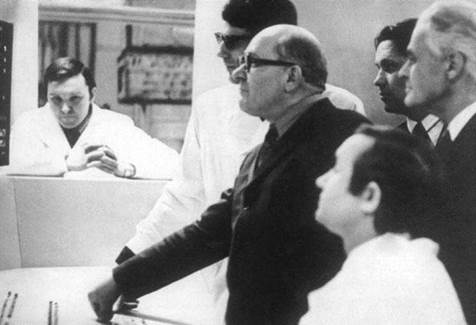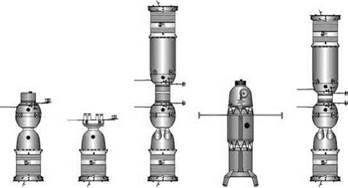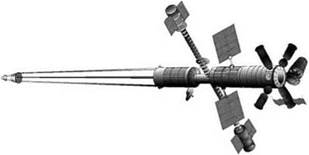OKB-l’S SPACE STATIONS
Owing to the protracted delays with the design and development of the TKS, it was decided to start Almaz operations using the Soyuz spacecraft as a crew ferry. The manner in which this decision was made is interesting. When the Almaz programme began in 1964, OKB-1 was involved in so many projects that it was overcommitted. In addition to adapting the Vostok capsule for the Voskhod missions, developing lunar and interplanetary probes, and developing several versions of the new Soyuz spacecraft – including the Soyuz-P and Soyuz-R for military missions – Korolev’s designers were developing the N1 launch vehicle. When the Americans announced their intention to develop the MOL, Korolev transferred the military Soyuz projects to OKB-1’s Branch No. 3 in Kybishev (now Samara), which had developed the R-7 missile that was used to launch the early Sputniks and, with an additional stage, the Vostok spacecraft. Chief Designer Dmitriy Kozlov, who had led Branch No. 3 since 1959, eagerly accepted the transferred projects. The objective of the Soyuz-P was to rendezvous with an American military satellite in order to inspect and, if required, destroy it.[10] However, it was decided that to have a crew fly such a mission would be too risky, and in 1965 the project was cancelled in a favour of an unmanned satellite interceptor (IS) proposed by Chelomey.
This left Branch No. 3 of OKB-1 with only the Soyuz-R.[11] For our story, this is an important project since it was actually the first space station ever to be endorsed by the Soviet government – although admittedly it was of modest scope in comparison to Almaz. The order was signed by Defence Minister Marshal Rodion Malinovskiy on 18 June 1964, six months after the announcement by the Americans of their intention to develop the MOL, and it was included in the 5-year development plan drawn up for the Soviet military space programme covering the period 1964 to 1969. Representatives of the Ministry of Defence, MOM and the Academy of Sciences conducted a major technical and scientific assessment of the project in early 1965, and accepted that it was viable. The mission was to involve two separately launched unmanned spacecraft, both of which were based on the Soyuz design. Once docked,
|
Dmitriy Kozlov (centre), the Chief Designer of Branch No. 3 of TsKBEM in Kybishev (now Samara). |
they would form a small space station with total mass of 13 tonnes, a length of 15 metres and a habitable volume of about 31 cubic metres. In documents drawn up by OKB-1 Branch No. 3, this two-part facility had the technical code 11F71. A third Soyuz (11F72) would be launched with two cosmonauts. After docking, they would move into the station through a hermetic transfer tunnel to pursue a programme of military observations and experiments. In December 1965 Kozlov visited General Nikolay Kamanin who as Deputy Chief of the Soviet Air Force was in charge of the manned space programme to develop a joint plan to make use of the Soyuz-R station, for which military cosmonauts were already in training at the TsPK.
However, when the Americans began to fly Gemini missions in 1965 the Kremlin, fearful that this spacecraft would be used to conduct satellite interceptions, realised that even if the work at OKB-1 and OKB-52 progressed as planned, their respective spacecraft would not become available until 1968. In August 1965, therefore, the Kremlin ordered Kozlov to urgently develop a new military spacecraft which would be able to be introduced before the end of 1966.[12] [13] The project was named ‘Zvezda’ (‘Star’), but was also known as the Soyuz-VI.11 So, having lost the Soyuz-P, Kozlov once again had two manned spacecraft for military use.
The Soviet space programme suffered a setback in January 1966 when Korolev died. The Science and Technical Committee of the Ministry of Defence conducted a detailed review of the two long-term military projects, and decided to terminate the Soyuz-R. The 11F71 code was reassigned to Almaz. Then, reluctant to wait for Chelomey’s TKS, the committee recommended using the 11F72 Soyuz that Kozlov was developing to ferry crews to the Soyuz-R station. At this point it is necessary to explain that the general designation for Soyuz spacecraft was 7K, with the Soyuz-P being 7K-P, the Soyuz-R being 7K-R, the Soyuz-VI being 7K-VI, and the 11F72 variant being 7K-TK.[14] Kozlov was told to give the technical documentation for the Soyuz-R station to Chelomey to enable the Almaz to be modified to accommodate its ferry craft. The 7K-TK would deliver crews to the Almaz stations until the more capable TKS became available. This made Almaz the first case of a major Soviet manned space programme to integrate work by highly competitive design bureaus. But establishing the necessary coordination of the two teams in order to revise the Almaz design to use the much smaller Soyuz as a crew ferry took time, and in late 1966 the Military-Industrial Commission (VPK), which was an institution created by the Council of Ministers to implement the decisions of Communist Party, issued decree No. 304 accepting the delay in the development of the Soyuz crew ferry for Almaz and calling for tests of Almaz systems in 1968 and the first operational flight in 1969. Hence, by 1967, after much political manoeuvring by politicians, generals and chief designers, Almaz had become the principal Soviet military manned space programme, and the nation’s only space station project.
Nevertheless, the Zvezda reconnaissance spacecraft was still under development by Kozlov. After a series of technical problems during the unmanned test flights of the Soyuz, Kozlov directed his engineers to change the configuration for Zvezda. In particular, it was to have a crew of two cosmonauts who would wear pressure suits, whereas the Soyuz was to have a crew of three who would not wear pressure suits – the precedent for this decision by Korolev being the three-man Voskhod mission in 1964. At launch the Zvezda spacecraft would weigh 6.6 tonnes, be 8 metres in length, 2.8 metres in diameter and have a volume of 12 cubic metres. The total mass of a man, his pressure suit, couch and life support system was approximately 400 kg. Early in the development of the Zvezda project it was expected that the capacity of the Soyuz rocket would restrict the spacecraft to a single cosmonaut, but continued redesign of the descent module enabled a second couch to be installed. The Zvezda spacecraft was to be capable of a 1-month mission, which was twice the maximum duration of the American Gemini.
An interesting difference in design between the Soyuz and Zvezda spacecraft was the descent module. In the case of the Soyuz, this was located in line between the orbital module (in front) and the propulsion module (behind). The descent module is actually a command module, with the couches on its broad base facing an array of controls and instrument panels. This arrangement severely limited the visibility. The
spherical orbital module blocked the view directly ahead. Sitting in the centre couch, the commander had only a 15-degree-wide periscope for rendezvous and docking operations. The cosmonauts seated left and right had side-facing windows, but were unable to see the target vehicle. As Zvezda was not required to dock with a satellite, Kozlov optimised visibility to enable the crew to conduct a visual inspection of the target. In particular, he moved the descent module to the forward end of the vehicle and inserted the orbital module between it and the propulsion module. Although this arrangement had obvious advantages in comparison to the Soyuz, the design had the important disadvantage that the access hatch to the orbital module was through the heat shield of the descent module, and there was some concern that the hatch would not withstand the thermal stress of re-entry.[15] Although dynamic tests conducted at Branch No. 3 of OKB-1 showed that the hatch was safe, there were lingering doubts. Another issue was Zvezda’s power system. Instead of using either chemical storage batteries or solar panels, it was to have a pair of radioisotope thermal generators that would use thermocouples to transform radiogenic heat into electricity. Although these were to be located at the rear of the propulsion module, the potential exposure of the crew to radiation from this system was a matter of some concern. Finally, in view of the fact that the mission was overtly military, a rapid-firing Nudelyman gun was added for protection from an American satellite – killer.[16]’[17] The entire spacecraft, with its gun, entered ground testing in 1967 and, despite the safety concerns, in late July the Central Committee and Council of Ministers endorsed Zvezda with the first launch being scheduled in 1968 as a prelude to in-orbit military operations in 1969.
In the meantime six military cosmonauts began to train at the TsPK in September 1966 for the Zvezda programme. They were later joined by two new cosmonauts. The group was led by veteran cosmonaut Pavel Popovich. The first two potential crews were soon selected. However, the project was derailed in October 1967 when Vasiliy Mishin, now Chief Designer of the TsKBEM and Kozlov’s boss, intervened. The root of the issue was that Mishin took exception to the degree of independence that Korolev had given Kozlov. By machinations and political intrigues exploiting his MOM and VPK contacts, in January 1968 Mishin, with the support of Minister Afanasyev, directed Kozlov to cancel Zvezda. When General Kamanin heard of this he supported Kozlov, but was unable to have the cancellation order reversed.
As a substitute for Zvezda, Mishin suggested the Orbital Research Station (OIS) Soyuz-VI (11F730), and in May 1968 sent a technical specification to the Ministry of Defence. It was based on the Soyuz-R, would fly at an altitude of 250 km at an inclination of 51.6 degrees to the equator, and have solar panels for power and a passive docking system incorporating a hermetic tunnel. The crew would arrive in a
Soyuz 7K-S (11F732)[18] and spend typically a month on board using about 1,000 kg of equipment supplied by the Academy of Sciences and the Ministry of Defence. In addition, the plan called for an unmanned cargo craft 7K-SG (11F735) to supply the occupied station with food, water, air and additional equipment.[19]’[20] Kozlov was not excluded – Branch No. 3 of the TsKBEM joined this project in June 1968, but in a subsidiary rather than a leading role.
However, at that time the TsKBEM was fully committed both to redesigning the Soyuz following the loss of Vladimir Komarov on its first manned mission, and to the development of the L1 and L3 lunar programmes. The low priority assigned to the OIS is indicated by the fact that the TsPK never even received a simulator for it, and when the Zvezda cosmonauts were transferred to the OIS they were given only theoretical, physical and survival training. By the end of 1969 it had been decided to start a much more ambitious project, and in February 1970 Afanasyev cancelled the OIS and the cosmonauts were reassigned to the Almaz space station.
There were also considerably more ambitious space stations projects initiated by OKB-1/TsKBEM. Notably, in Korolev’s time there was the Multirole Space Base Station (MKBS) that was to be launched by the N1 rocket. Work on this station had to be halted, awaiting the introduction of the giant rocket. When the N1 tests finally began in early 1969, Mishin appointed Vitaliy Bezverby, an expert in the ballistics of space vehicles, to manage the MKBS project. The core of the station was to be a cylinder 20 metres in length and 6 metres in diameter. Some 60 metres away, and connected by three long supports, there was to be a nuclear power unit and a plasma electric engine, increasing the length to 100 metres. The total mass of between 220
|
Early planned Soyuz variants: the Earth orbital version (left), Soyuz-P, Soyuz-R space station, Zvezda, and Soyuz-VI miniature space station. (Courtesy Mark Wade) |
and 250 tonnes was to have included 80-88 tonnes of modules and 15-20 tonnes of scientific equipment. It would operate at an altitude in the range 400-450 km and at inclinations of either 51.6 or 91 degrees – the latter being a polar orbit which would enable it to survey the entire globe on a daily basis. It was to have a main crew of six cosmonauts, and an operational life of at least a decade. Two modules providing a volume of 30 cubic metres were to be spun in the manner of a centrifuge to simulate a gravity of 0.8 g. The 200-kW output of the nuclear power unit was to be supplemented by 14 kW from solar panels having a total area of 140 square metres. The station was to have eight docking ports to enable it to serve as a ‘space port’ for a variety of types of spacecraft, some of which would be unmanned – after being serviced by the station’s crew, an unmanned spacecraft would depart to conduct an automated programme of military reconnaissance. The MKBS was to be equipped to protect itself. In fact, its design included numerous concepts similar to those that were envisaged for the ‘Star Wars’ programme which was initiated in the 1980s by President Ronald Reagan. Although the MKBS remained a paper study, many years later some of its elements were included in the design of the Mir space station.
In all the time that the TsKBEM was concentrating on the redesign of the Soyuz, the L1 project and the development of the N1-L3, Chelomey progressively worked to reduce the degree to which Almaz was dependent on Mishin’s bureau. In 1969 he rejected the Soyuz 7K-TK as the crew ferry in favour of the TKS, which was being developed under the leadership of Yakov Nodelyman. By the time the draft design was completed in 1969, the TKS had grown in length to 13 metres, had a volume of 50 cubic metres and a mass of almost 22 tonnes – making it heavier than the Almaz station itself! Although eager to be free of the TsKBEM, Chelomey borrowed some aspects of the Zvezda spacecraft; in particular modifying a quick-firing Nudelyman – Richter NR-23 cannon used by the Tu-22 bomber.[21] This had a maximum range of
|
The giant MKBS space station designed by the TsKBEM, showing four Soyuz type spacecraft docked at the main compartment (far right), an artificial-gravity module at each end of the perpendicular boom, and a nuclear power module supported by three long pylons. (Courtesy Mark Wade) |
3 km, fired 0.2-kg projectiles at a speed of 690 metres per second and had a rate of 950 rounds per minute. Since the gun would be in a fixed position, it would be necessary to align the station to aim the gun at a target, and the correction engines were to maintain the station’s stability while the gun was firing. It was expected that the gun would be able to hit and destroy a target within five seconds.
The great irony was that while the Soviet Union was working on all these military projects, the development of the American MOL had fallen behind schedule, and in 1969 this suffered the same fate as the Dyna-Soar ‘space plane’ by being cancelled shortly before its preliminary test flight. Nevertheless, the Americans had not given up on the idea of a space station.













